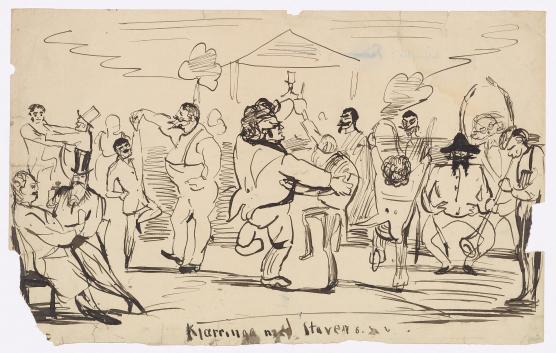
Edvard Munch is rarely associated with humour and jokes, but in fact there are a number of such elements in his diversified production of art. As a child and a teenager he made caricature drawings of his teachers, and inspired by cartoons in humoristic magazines, he made illustrated jokes, where the fun was verbal rather than visual (MM.T.02708-16). For Christmas 1882 he even published a leaflet with printed joke drawings. During the 1880s, he made a large number of portraits, often exaggerating the characteristics to such a degree, that they are close to caricatures.
In 1891, Munch for the first time employed caricature to retaliate for what he regarded as an unjust attack. He had applied for the State Scholarship for Artists for the third year in a row, claiming that he had been unable to make full use of the grant the previous year due to illness. This prompted the author Bjørnstjerne Bjørnson to write a newspaper note, criticizing the use of artist scholarships as a kind of health insurance. Munch reacted by drawing caricatures of Bjørnson as a repressive and dominating figure on the Norwegian cultural scene (MM.T.01312).
After the definite break-up in 1902 with Tulla Larsen, with whom he had had a turbulent relationship for several years, caricature became an important tool for expressing his indignation over their mutual friends, whom he felt had betrayed him. Christian Krohg, Sigurd Bødtker, and Gunnar Heiberg were frequently portrayed in malicious caricatures, the two last-mentioned often in the shape of animals (MM.T.00138-06). Gradually even other incidents where Munch felt persecuted or unfairly treated were made subjects of drawings and lithographs.
Among these caricatures we also find self-ironic drawings, where he has portrayed himself in a perpetual fight with bureaucracy or searching for a lost button (MM.T.00226-26).
In later years, conflict with a neighbor at Ekely gave birth to a series of drawings describing repeated attacks by the neighbor’s fierce dog (MM.T.00164-53-verso), and during the 1930s the tax authorities were ridiculed in the molbo story “The Hen Laying Golden Eggs”. Both the fierce dog and the molbos were published as lithographic series.
(GW)
